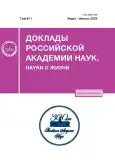SPECTRAL ANALYSIS OF HEART RATE VARIABILITY BASED ON THE HILBERT-HUANG METHOD
- 作者: Grinevich A.A.1, Chemeris N.K.1
-
隶属关系:
- Institute of Cell Biophysics of Russian Academy of Sciences
- 期: 卷 511, 编号 1 (2023)
- 页面: 395-398
- 栏目: Articles
- URL: https://journals.rcsi.science/2686-7389/article/view/135663
- DOI: https://doi.org/10.31857/S2686738923700282
- EDN: https://elibrary.ru/JJZIMH
- ID: 135663
如何引用文章
全文:
详细
Analysis of heart rate variability (HRV) is widely used for noninvasive assessment of the state of its regulation systems. The aim of the research was to evaluate the capabilities of the Hilbert-Huang method for calculating spectral parameters of HRV in comparison with the commonly used Fourier analysis. Fourier analysis allows to estimate averaged spectral amplitudes and power of HRV oscillations in fixed frequency intervals, which are associated with the activity of sympathetic, parasympathetic and humoral regulation systems. Using the Hilbert-Huang method, we revealed 4 spectral components, described by Gauss functions, in which HRV oscillations are concentrated, and showed the absence of fixed boundaries between them. The obtained energy quantitative characteristics of the spectral components of heart rhythm oscillations can serve as the basis for diagnostic methods of its regulation, supplementing the commonly used ones.
作者简介
A. Grinevich
Institute of Cell Biophysics of Russian Academy of Sciences
编辑信件的主要联系方式.
Email: grin_aa@mail.ru
Russian Federation, Pushchino
N. Chemeris
Institute of Cell Biophysics of Russian Academy of Sciences
编辑信件的主要联系方式.
Email: nikolai.chemeris@mail.ru
Russian Federation, Pushchino
参考
- Heart rate variability: standards of measurement, physiological interpretation and clinical use. Task Force of the European Society of Cardiology and the North American Society of Pacing and Electrophysiology // Circulation. 1996. V. 93. P. 1043–1065.
- Huang N.E., Zheng S., Steven R.L., et al. The Empirical Mode Decomposition and the Hilbert Spectrum for Nonlinear and Non-Stationary Time Series Analysis // Proceedings of the Royal Society of London. Series A: Mathematical, Physical and Engineering Sciences. 1998. V. 454. P. 903–95.
- Тычков А.Ю. Применение модифицированного преобразования Гильберта-Хуанга для решения задач цифровой обработки медицинских сигналов // Известия высших учебных заведений. Поволжский регион. Технические науки. 2018. Т. 3. № 47. С. 70–82.
- Гриневич А.А., Гарамян Б.Г., Чемерис Н.К. Локализация механизмов амплитудно-частотной модуляции пульсового кровенаполнения микрососудистого русла мягких тканей. Пилотное исследование // ДАН. 2022. Т. 504. № 3. С. 223–228.
- Li H., Kwong S., Yang L., et al. Hilbert-Huang transform for analysis of heart rate variability in cardiac health // IEEE/ACM Trans Comput Biol Bioinform. 2011. V. 8 (6). P. 1557–67.
- Lin C.F., Zhu J.D. Hilbert-Huang transformation-based time-frequency analysis methods in biomedical signal applications // Proc Inst Mech Eng H. 2012. V. 226 (3). P. 208–16.
- Флейшман А.Н., Кораблина Т.В., Петровский С.А. и др. Сложная структура и нелинейное поведение very low frequency вариабельности ритма сердца: модели анализа и практические приложения // Изв. вузов “ПНД”. 2014. Т. 22. № 1. С. 55–70.
- Chang C.C., Hsiao T.C., Hsu H.Y. Frequency range extension of spectral analysis of pulse rate variability based on Hilbert–Huang transform // Med Biol Eng Comput. 2014. V. 52. P. 343–351.
- Togo F., Kiyono K., Struzik Z.R., et al. Unique very low-frequency heart rate variability during deep sleep in humans // IEEE Trans Biomed. 2006. V. 53. № 1. P. 28.
- Plaza-Florido A., Sacha J., Alcantara J.M.A. Short-term heart rate variability in resting conditions: methodological considerations // Kardiol Pol. 2021. V. 79 (7–8). P. 745–755.










